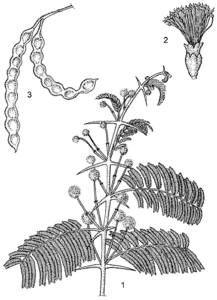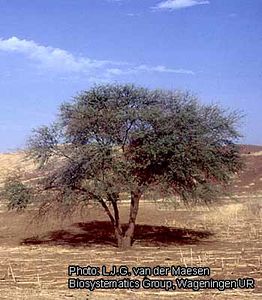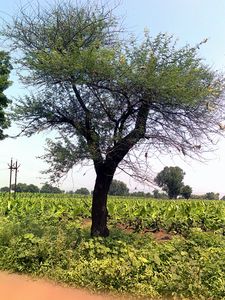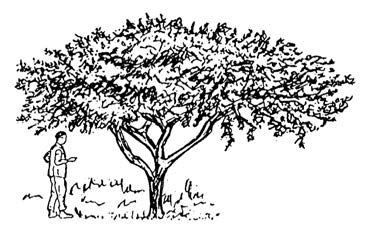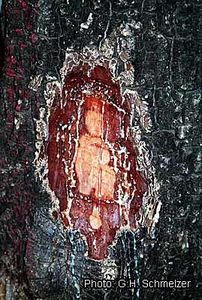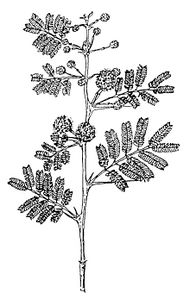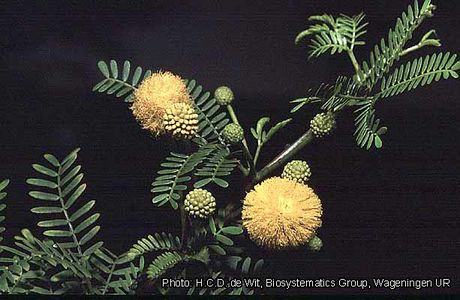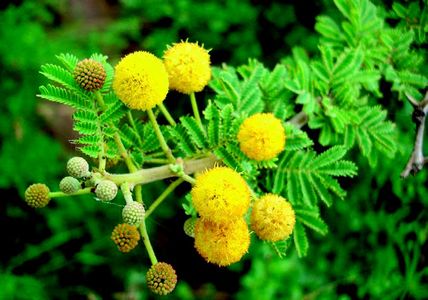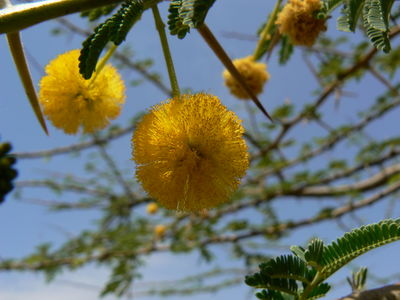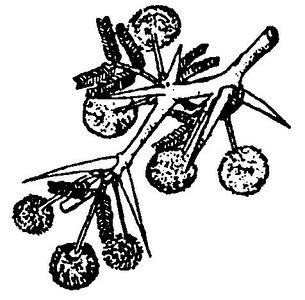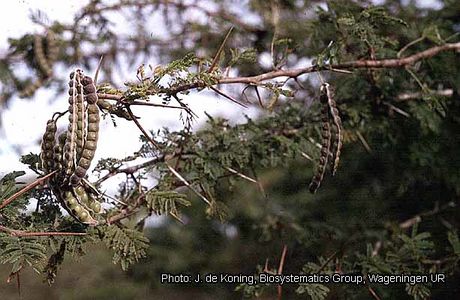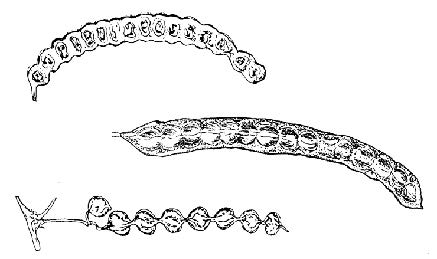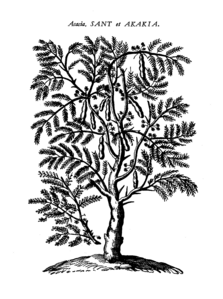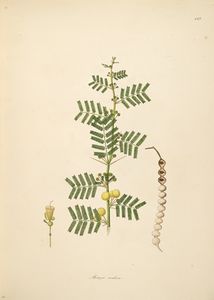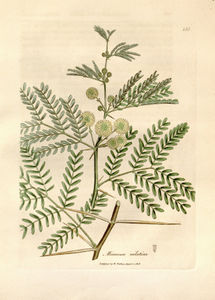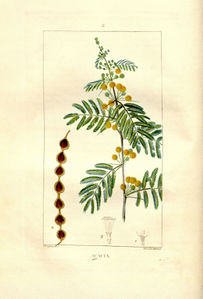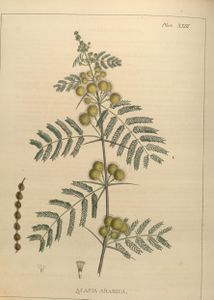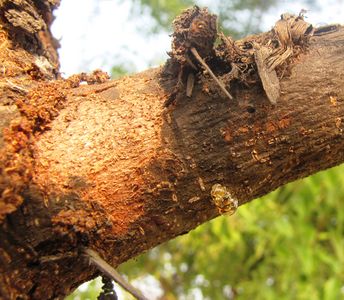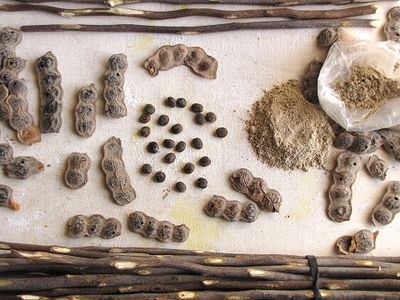Vachellia nilotica : Différence entre versions
(→Description) |
|||
| (25 révisions intermédiaires par le même utilisateur non affichées) | |||
| Ligne 15 : | Ligne 15 : | ||
|titre=Résumé des usages | |titre=Résumé des usages | ||
|texte=*exsudat : gomme arabique | |texte=*exsudat : gomme arabique | ||
| − | *tanin | + | *tanin : écorce, fruit |
*graines grillées consommées en condiment | *graines grillées consommées en condiment | ||
*fourrage : feuilles, gousses, graines | *fourrage : feuilles, gousses, graines | ||
*médicinal : écorce, feuilles, fruits | *médicinal : écorce, feuilles, fruits | ||
| + | *suc extrait des fruits | ||
*fibres de l'écorce : cordes | *fibres de l'écorce : cordes | ||
*planté comme arbre d'alignement, d'ombrage, pour la fixation des sols | *planté comme arbre d'alignement, d'ombrage, pour la fixation des sols | ||
*bois d'œuvre | *bois d'œuvre | ||
*bois de feu et charbon de bois | *bois de feu et charbon de bois | ||
| + | *hôte d'insectes à laque | ||
*graines à usage magique | *graines à usage magique | ||
| + | *mellifère | ||
}} | }} | ||
| − | |||
== Description == | == Description == | ||
| − | |||
| − | |||
| − | |||
| − | |||
| − | |||
| − | |||
| − | |||
| − | |||
| − | |||
| − | |||
<gallery mode="packed"> | <gallery mode="packed"> | ||
File:Linedrawing Acacia nilotica.gif|''Acacia nilotica''<br>1, rameau en fleurs ;<br>2, fleur ; 3, fruits<br>Redessiné et adapté par Iskak Syamsudin | File:Linedrawing Acacia nilotica.gif|''Acacia nilotica''<br>1, rameau en fleurs ;<br>2, fleur ; 3, fruits<br>Redessiné et adapté par Iskak Syamsudin | ||
| Ligne 53 : | Ligne 45 : | ||
File:Acacia nilotica drawing fruits Bekele-Tessemma Ethiopia.jpg|fruits | File:Acacia nilotica drawing fruits Bekele-Tessemma Ethiopia.jpg|fruits | ||
</gallery> | </gallery> | ||
| + | *arbre épineux atteignant 20 m de haut | ||
| + | *écorce fissurée à crevassée, noirâtre | ||
| + | *feuilles composées bipennées, de 4-8 cm de long, avec 3-6 paires de pinnules | ||
| + | *10-25 paires de folioles par pinnule, de 0,7 cm de long | ||
| + | *épines par paire à la base des feuilles, jusqu’à 8 cm de longueur, droites et fines ou courbes | ||
| + | *inflorescence : capitule globuleux, jaunes, de 1,2-1,5 cm de diamètre | ||
| + | *fruits : gousses plates ou cylindriques, droites ou courbes, plus ou moins étranglées, glabres ou pubescentes, de 10-15 cm de long | ||
| + | *graine brune, plus ou moins plate et ronde, atteignant 9 mm de diamètre | ||
== Noms populaires == | == Noms populaires == | ||
{| class="wikitable" style="width:100%;" | {| class="wikitable" style="width:100%;" | ||
| français | | français | ||
| − | | gommier rouge ; acacia de Cayenne (Guadeloupe, Martinique) ; acacia-savane, acacia saline, pompon jaune (Martinique) | + | | gommier rouge ; acacia de Cayenne (Guadeloupe, Martinique) ; acacia-savane, acacia saline, pompon jaune (Martinique) ; acacia à gomme arabique (St-Barthélemy) (Rollet) ; babla, nebneb (PROTA) |
|- | |- | ||
| anglais | | anglais | ||
| − | | Egyptian thorn, scented pod acacia | + | | Egyptian thorn, scented pod acacia ; cassie (Antigua) ; casha (Anguilla) ; gum arabic tree (Puerto Rico) (Rollet) ; babul acacia, scented thorn (PROTA) |
| + | |- | ||
| + | | portugais | ||
| + | | tchanga, goma da Índia (PROTA) | ||
| + | |- | ||
| + | | arabe | ||
| + | | | ||
| + | * امور - āmūr, لامور - lāmūr | ||
| + | * تݣرت - taggart, tiggart, taġġart, tiġġart, اݣر - āgar (Touaregs et Sud algérien ; Monteil, 1953 ; Sitouh, 1989) | ||
| + | * صنط - ṣanṭ, ṣunṭ (Moyen-Orient, Egypte, Soudan, Boulos, 1983 ; Dalziel, 1955) | ||
| + | * شوك مصري - šūka maṣriya, شوك قبطي - šūka qibṭiya (litt. : épine copte) (Egypte, Boulos, 1983) | ||
| + | * ݣرتي - gurtī (Egypte, Boulos, 1983) | ||
| + | * قراز - qaraẓ (Moyen-Orient, Boulos, 1983) : s'applique plus spécialement à la gousse | ||
| + | * ببول - babūl (Inde, Pakistan) (Khan Usmanghani & al., 1986, Chopra & al., 1956) | ||
| + | * موغلان - mūġilān (Pakistan, Khan Usmanghani & al., 1986) : du classique اُمّ غيلان - ūmm-ġaylān | ||
| + | * عاقاقيا - āqāqihā : ce terme s'applique classiquement pour le suc et l'extrait des gousses ; mais au Sahara occidental, il semble s'appliquer à la gomme | ||
| + | * صلّاخا - ṣellāẖā (Sahara occidental) : pour l'écorce (Bellakhdar) | ||
| + | |- | ||
| + | | ouolof | ||
| + | | neb-neb ; gonake (subsp. ''tomentosa'') (Adanson) | ||
|- | |- | ||
| foulfoulde | | foulfoulde | ||
| Ligne 66 : | Ligne 85 : | ||
|- | |- | ||
| swahili | | swahili | ||
| − | | mgunga, mjungu, mtetewe | + | | mgunga, mjungu, mtetewe (PROTA) |
|- | |- | ||
| bengali | | bengali | ||
| − | |বাবলা - babala | + | | বাবলা - babala |
|- | |- | ||
| gujarati | | gujarati | ||
| − | |બાવળ - baval, બાવળિયો - bavaliyo | + | | બાવળ - baval, બાવળિયો - bavaliyo |
|- | |- | ||
| hindi | | hindi | ||
| बबूल - babūl, कीकर - kikar | | बबूल - babūl, कीकर - kikar | ||
|- | |- | ||
| − | | kannada | + | | kannada |
| − | |ಗೊಬ್ಳಿ ಮರ - gobli mara, ಕರಿಜಾಲಿ - karijaali | + | | ಗೊಬ್ಳಿ ಮರ - gobli mara, ಕರಿಜಾಲಿ - karijaali |
|- | |- | ||
| konkani | | konkani | ||
| − | |बाबुळ - babul | + | | बाबुळ - babul |
|- | |- | ||
| malayalam | | malayalam | ||
| − | |കരിവേലം - karivelam | + | | കരിവേലം - karivelam |
|- | |- | ||
| marathi | | marathi | ||
| − | |बाभूळ - babhul, बाभळी - babhali, बाभळ - babhal | + | | बाभूळ - babhul, बाभळी - babhali, बाभळ - babhal |
|- | |- | ||
| Rajasthan | | Rajasthan | ||
| − | |banvalia | + | | banvalia |
|- | |- | ||
| − | | | + | | sanskrit |
| − | |बब्बु - babbul, बब्बूल - babbulaha, पङ्क्ति - panktiha, सोमवृक्ष - somavriksha, तीक्ष्ण कण्टक - tikshna kantaka, वर्वू - varvu, वर्वुरः - varvrurha, युग्मकण्ट - yugmakanta | + | | बब्बु - babbul, बब्बूल - babbulaha, पङ्क्ति - panktiha, सोमवृक्ष - somavriksha, तीक्ष्ण कण्टक - tikshna kantaka, वर्वू - varvu, वर्वुरः - varvrurha, युग्मकण्ट - yugmakanta |
|- | |- | ||
| tamoul | | tamoul | ||
| Ligne 99 : | Ligne 118 : | ||
|- | |- | ||
| telugu | | telugu | ||
| − | |నల్లతుమ్మ - nalla tumma | + | | నల్లతుమ్మ - nalla tumma |
|} | |} | ||
| Ligne 108 : | Ligne 127 : | ||
*''Mimosa nilotica'' L. (1753) | *''Mimosa nilotica'' L. (1753) | ||
| − | + | synonymes : | |
| + | *''Acacia arabica'' (Lam.) Willd. (1806) | ||
| + | *''Acacia vera'' Willd. (1806) | ||
*''Acacia nilotica'' (L.) Delile (1813) ("1812") | *''Acacia nilotica'' (L.) Delile (1813) ("1812") | ||
| + | *''Acacia scorpioides'' (L.) W. Wight (1905) | ||
| + | *''Mimosa scorpioides'' L. (1753) | ||
| + | *''Mimosa arabica'' Lam. (1783) | ||
| + | |||
| + | === subsp. ''tomentosa'' === | ||
| + | ''Vachellia nilotica'' subsp. ''tomentosa'' (Benth.) Kyal. & Boatwr. | ||
| + | |||
| + | basionyme : | ||
| + | *''Acacia arabica'' var. ''tomentosa'' Benth. (1842) | ||
| + | |||
| + | synonyme : | ||
| + | *''Acacia nilotica'' subsp. ''tomentosa'' (Benth.) Brenan (1957) | ||
| + | |||
| + | Sahara & Sahel | ||
| + | |||
| + | === subsp. ''adstringens'' === | ||
| + | subsp. ''adstringens'' (Schumach. & Thonn.) Roberty (1948) | ||
| + | |||
| + | basionyme : | ||
| + | *''Mimosa adstringens'' Schumach. & Thonn. (1827) | ||
| + | |||
| + | synonyme : | ||
| + | *''Acacia adansonii'' Guill. & Perr. | ||
| + | *''Acacia nilotica'' subsp. ''adansonii'' (Guill. & Perr.) Brenan | ||
== Cultivars == | == Cultivars == | ||
| Ligne 115 : | Ligne 160 : | ||
== Histoire == | == Histoire == | ||
<gallery mode="packed"> | <gallery mode="packed"> | ||
| + | File:Sant Alpin 1735.png|Sant, Alpin 1735, ''[[De Plantis Aegypti]]'', 6v ; 6 | ||
| + | File:Vachellia nilotica Roxburgh 1798 2-149.jpg|Roxburgh, 1798, ''Plants of the coast of Coromandel'', vol. 2, pl. 149 | ||
File:Mimosa nilotica Woodville 1832.jpg|Woodville ''et al.'', 1832, ''Medical Botany'', 3th edition, vol. 3: t. 158 | File:Mimosa nilotica Woodville 1832.jpg|Woodville ''et al.'', 1832, ''Medical Botany'', 3th edition, vol. 3: t. 158 | ||
File:Acacia nilotica Chaumeton 1933.jpg|Chaumeton, 1833, ''Flore médicale'', vol. 1: t. 2 | File:Acacia nilotica Chaumeton 1933.jpg|Chaumeton, 1833, ''Flore médicale'', vol. 1: t. 2 | ||
| Ligne 127 : | Ligne 174 : | ||
File:Acacia nilotica - seeds, seed pods, twigs, powder.jpg|produis médicinaux : gousses, graines, ramilles pour brosses à dents | File:Acacia nilotica - seeds, seed pods, twigs, powder.jpg|produis médicinaux : gousses, graines, ramilles pour brosses à dents | ||
</gallery> | </gallery> | ||
| + | {{Citation encadré | ||
| + | |texte=BABOOL-BARK. GUM ARABIC TREE. SUNTWOOD. North and central Africa and Southwest Asia. It furnishes a gum arable of superior quality<ref>U. S. Disp. 6. 1865.</ref>. The bark, in times of scarcity, is ground and mixed with flour in India<ref>Brandis, ''D. Forest Fl.'' 182. 1874.</ref>, and the gum, mixed with the seeds of sesame, is an article of food with the natives<ref>Drury, H. ''Useful Pls. Ind.'' 5. 1858.</ref>. The gum serves for nourishment, says Humboldt<ref>Humboldt, A. ''Polit. Essay New Spain'' 2:423. 1811.</ref>, to several African tribes in their passages through the dessert. In Barbary, the tree is called ''atteleh''. | ||
| + | <references/> | ||
| + | |auteur =[[:en:Acacia (Sturtevant, 1919)#Acacia arabica|Sturtevant, ''Notes on edible plants'', 1919]]. | ||
| + | }} | ||
| + | {{Citation encadré | ||
| + | |texte=Une gomme exsude du tronc (encre, mucilage, médicinale). Fruit pour le tanin. Bois dur, bois de feu. Mellifère. Ornemental. | ||
| + | |auteur=Rollet, 2010. | ||
| + | }} | ||
| + | {{Citation encadré | ||
| + | |texte=Planted for production of the tannin rich bark in India; an extract ("succus acaciae"), similar as from catechu, is extracted from the fruits, that is used in tannery. Cultivated for production of the brown gum ("chati gum" or "Salem gum") in the Antilles and Africa. Pods are used for fodder in Africa. Frequently planted for wind protection in Pakistan. Used also as host for lac insects. This species is divided into nine subspecies with distinctive geographical ranges. | ||
| + | |auteur=Mansfeld. | ||
| + | }} | ||
== Références == | == Références == | ||
| + | *[[Adanson, Michel]], 1777. Premier Mémoire sur l'Acacia des Anciens, & sur quelques autres Arbres du Sénégal qui portent la gomme rougeâtre, appelée communément Gomme Arabique. ''Histoire de l'Académie Royale des Sciences'', année 1773, Paris. 1-17. [https://gallica.bnf.fr/ark:/12148/bpt6k3572b/f1.image Gallica]. (145-161 du pdf) [[Premier Mémoire sur l'Acacia (1777)#PREMIÈRE ESPÈCE|Voir sur Pl@ntUse]] | ||
*Arbonnier, Michel, 2000. ''Arbres, arbustes et lianes des zones sèches d'Afrique de l'Ouest''. CIRAD, MNHN, UICN. 542 p. 2e éd. augmentée : 2002. | *Arbonnier, Michel, 2000. ''Arbres, arbustes et lianes des zones sèches d'Afrique de l'Ouest''. CIRAD, MNHN, UICN. 542 p. 2e éd. augmentée : 2002. | ||
*Arbonnier, Michel, 2000. ''Trees, shrubs and lianas of West African dry zones ''. CIRAD, Margraf, MNHN. 573 p. | *Arbonnier, Michel, 2000. ''Trees, shrubs and lianas of West African dry zones ''. CIRAD, Margraf, MNHN. 573 p. | ||
*Bekele-Tesemma, Azene, 2007. ''Useful trees and shrubs for Ethiopia. Identification, propagation and management for 17 agroclimatic zones''. Nairobi, ICRAF - RELMA. 550 p. (''Technical Manual'' 6). [[:en:Acacia nilotica (Bekele-Tesemma, 2007)|Voir l'article]] | *Bekele-Tesemma, Azene, 2007. ''Useful trees and shrubs for Ethiopia. Identification, propagation and management for 17 agroclimatic zones''. Nairobi, ICRAF - RELMA. 550 p. (''Technical Manual'' 6). [[:en:Acacia nilotica (Bekele-Tesemma, 2007)|Voir l'article]] | ||
*Eyog Matig, O., Ndoye, O., Kengue, J. et Awono, A. (eds), 2006. ''Les Fruitiers Forestiers Comestibles du Cameroun''. Rome, IPGRI, CIFOR, IRAD. XIV-204 p. [[Acacia nilotica (Fruitiers du Cameroun)|Voir l'article]] | *Eyog Matig, O., Ndoye, O., Kengue, J. et Awono, A. (eds), 2006. ''Les Fruitiers Forestiers Comestibles du Cameroun''. Rome, IPGRI, CIFOR, IRAD. XIV-204 p. [[Acacia nilotica (Fruitiers du Cameroun)|Voir l'article]] | ||
| − | *Rollet, Bernard et coll., 2010. ''Arbres des Petites Antilles''. | + | *Rollet, Bernard et coll., 2010. ''Arbres des Petites Antilles''. Tome 1 : ''Introduction à la dendrologie''. 276 p. Tome 2 : ''Description des espèces''. 866 p. + 46 pl. coul. + CD de photos sur l'anatomie du bois. Basse-Terre, ONF. Voir [[Acacia nilotica (Rollet, Antilles)|sur Pl@ntUse]]. |
== Liens == | == Liens == | ||
*[http://www.worldagroforestry.org/treedb2/speciesprofile.php?Spid=81 Agroforestree] | *[http://www.worldagroforestry.org/treedb2/speciesprofile.php?Spid=81 Agroforestree] | ||
| + | *[http://www.ville-ge.ch/musinfo/bd/cjb/africa/details.php?langue=fr&id=145532 BD des Plantes d'Afrique] | ||
*[http://www.biodiversitylibrary.org/search.aspx?SearchTerm=Vachellia%20nilotica&SearchCat= BHL] | *[http://www.biodiversitylibrary.org/search.aspx?SearchTerm=Vachellia%20nilotica&SearchCat= BHL] | ||
*[http://www.feedipedia.org/node/346 Feedipedia] | *[http://www.feedipedia.org/node/346 Feedipedia] | ||
| − | *[ | + | *[https://npgsweb.ars-grin.gov/gringlobal/taxon/taxonomydetail?id=465206 GRIN] |
*[http://www.ipni.org/ipni/simplePlantNameSearch.do?find_wholeName=Vachellia%20nilotica&output_format=normal&query_type=by_query&back_page=query_ipni.html IPNI] | *[http://www.ipni.org/ipni/simplePlantNameSearch.do?find_wholeName=Vachellia%20nilotica&output_format=normal&query_type=by_query&back_page=query_ipni.html IPNI] | ||
| − | + | *[http://mansfeld.ipk-gatersleben.de/apex/f?p=185:46:1771835676413::NO::module,mf_use,source,akzanz,rehm,akzname,taxid:mf,,botnam,0,,Acacia%20nilotica,20089 Mansfeld] | |
| − | *[http://mansfeld.ipk-gatersleben.de/ | + | *[http://www.plantnames.unimelb.edu.au/Sorting/Acacia.html Multilingual Plant Name Database] |
| − | *[http://www.plantnames.unimelb.edu.au/Sorting/ | + | |
*[https://hort.purdue.edu/newcrop/duke_energy/Acacia_nilotica.html NewCrop Purdue] | *[https://hort.purdue.edu/newcrop/duke_energy/Acacia_nilotica.html NewCrop Purdue] | ||
*[http://www.theplantlist.org/tpl1.1/search?q=Vachellia+nilotica Plant List] | *[http://www.theplantlist.org/tpl1.1/search?q=Vachellia+nilotica Plant List] | ||
| + | *[http://www.plantsoftheworldonline.org/taxon/urn:lsid:ipni.org:names:77089275-1 Plants of the World Online] | ||
*[[:en:Acacia nilotica (PROSEA)|PROSEA sur Pl@ntUse]] | *[[:en:Acacia nilotica (PROSEA)|PROSEA sur Pl@ntUse]] | ||
| − | *[[ | + | *[[Acacia nilotica (PROTA)|PROTA sur Pl@ntUse]] |
| − | *[ | + | *[https://inpn.mnhn.fr/espece/cd_nom/639351/tab/taxo TAXREF] |
| − | *[ | + | *[https://www.tela-botanica.org/apd-nn-145532 Tela Botanica] |
*[http://tropical.theferns.info/viewtropical.php?id=Vachellia%20nilotica Useful Tropical Plants Database] | *[http://tropical.theferns.info/viewtropical.php?id=Vachellia%20nilotica Useful Tropical Plants Database] | ||
*[https://fr.wikipedia.org/wiki/Acacia%20nilotica Wikipédia] | *[https://fr.wikipedia.org/wiki/Acacia%20nilotica Wikipédia] | ||
| + | *[http://www.worldfloraonline.org/taxon/wfo-0000205536 World Flora Online] | ||
| + | |||
[[Category:Vachellia]] | [[Category:Vachellia]] | ||
Version actuelle en date du 19 mai 2021 à 12:09
Vachellia nilotica
(L.) P. J. H. Hurter & Mabb.
| Ordre | Fabales |
|---|---|
| Famille | Fabaceae |
| Genre | Vachellia |
2n =
Origine : Afrique tropicale à Inde
sauvage et cultivé
| Français | gommier rouge |
|---|---|
| Anglais | Egyptian thorn |
- exsudat : gomme arabique
- tanin : écorce, fruit
- graines grillées consommées en condiment
- fourrage : feuilles, gousses, graines
- médicinal : écorce, feuilles, fruits
- suc extrait des fruits
- fibres de l'écorce : cordes
- planté comme arbre d'alignement, d'ombrage, pour la fixation des sols
- bois d'œuvre
- bois de feu et charbon de bois
- hôte d'insectes à laque
- graines à usage magique
- mellifère
Sommaire
Description
- arbre épineux atteignant 20 m de haut
- écorce fissurée à crevassée, noirâtre
- feuilles composées bipennées, de 4-8 cm de long, avec 3-6 paires de pinnules
- 10-25 paires de folioles par pinnule, de 0,7 cm de long
- épines par paire à la base des feuilles, jusqu’à 8 cm de longueur, droites et fines ou courbes
- inflorescence : capitule globuleux, jaunes, de 1,2-1,5 cm de diamètre
- fruits : gousses plates ou cylindriques, droites ou courbes, plus ou moins étranglées, glabres ou pubescentes, de 10-15 cm de long
- graine brune, plus ou moins plate et ronde, atteignant 9 mm de diamètre
Noms populaires
| français | gommier rouge ; acacia de Cayenne (Guadeloupe, Martinique) ; acacia-savane, acacia saline, pompon jaune (Martinique) ; acacia à gomme arabique (St-Barthélemy) (Rollet) ; babla, nebneb (PROTA) |
| anglais | Egyptian thorn, scented pod acacia ; cassie (Antigua) ; casha (Anguilla) ; gum arabic tree (Puerto Rico) (Rollet) ; babul acacia, scented thorn (PROTA) |
| portugais | tchanga, goma da Índia (PROTA) |
| arabe |
|
| ouolof | neb-neb ; gonake (subsp. tomentosa) (Adanson) |
| foulfoulde | gavdé, gavdi |
| swahili | mgunga, mjungu, mtetewe (PROTA) |
| bengali | বাবলা - babala |
| gujarati | બાવળ - baval, બાવળિયો - bavaliyo |
| hindi | बबूल - babūl, कीकर - kikar |
| kannada | ಗೊಬ್ಳಿ ಮರ - gobli mara, ಕರಿಜಾಲಿ - karijaali |
| konkani | बाबुळ - babul |
| malayalam | കരിവേലം - karivelam |
| marathi | बाभूळ - babhul, बाभळी - babhali, बाभळ - babhal |
| Rajasthan | banvalia |
| sanskrit | बब्बु - babbul, बब्बूल - babbulaha, पङ्क्ति - panktiha, सोमवृक्ष - somavriksha, तीक्ष्ण कण्टक - tikshna kantaka, वर्वू - varvu, वर्वुरः - varvrurha, युग्मकण्ट - yugmakanta |
| tamoul | கறுவேளை - karuvelai |
| telugu | నల్లతుమ్మ - nalla tumma |
Classification
Vachellia nilotica (L.) P. J. H. Hurter & Mabb. (2008)
basionyme :
- Mimosa nilotica L. (1753)
synonymes :
- Acacia arabica (Lam.) Willd. (1806)
- Acacia vera Willd. (1806)
- Acacia nilotica (L.) Delile (1813) ("1812")
- Acacia scorpioides (L.) W. Wight (1905)
- Mimosa scorpioides L. (1753)
- Mimosa arabica Lam. (1783)
subsp. tomentosa
Vachellia nilotica subsp. tomentosa (Benth.) Kyal. & Boatwr.
basionyme :
- Acacia arabica var. tomentosa Benth. (1842)
synonyme :
- Acacia nilotica subsp. tomentosa (Benth.) Brenan (1957)
Sahara & Sahel
subsp. adstringens
subsp. adstringens (Schumach. & Thonn.) Roberty (1948)
basionyme :
- Mimosa adstringens Schumach. & Thonn. (1827)
synonyme :
- Acacia adansonii Guill. & Perr.
- Acacia nilotica subsp. adansonii (Guill. & Perr.) Brenan
Cultivars
Histoire
Sant, Alpin 1735, De Plantis Aegypti, 6v ; 6
Usages
Cette espèce a probablement été la première source de gomme arabique connue des Anciens.
BABOOL-BARK. GUM ARABIC TREE. SUNTWOOD. North and central Africa and Southwest Asia. It furnishes a gum arable of superior quality[1]. The bark, in times of scarcity, is ground and mixed with flour in India[2], and the gum, mixed with the seeds of sesame, is an article of food with the natives[3]. The gum serves for nourishment, says Humboldt[4], to several African tribes in their passages through the dessert. In Barbary, the tree is called atteleh.
Une gomme exsude du tronc (encre, mucilage, médicinale). Fruit pour le tanin. Bois dur, bois de feu. Mellifère. Ornemental.
Planted for production of the tannin rich bark in India; an extract ("succus acaciae"), similar as from catechu, is extracted from the fruits, that is used in tannery. Cultivated for production of the brown gum ("chati gum" or "Salem gum") in the Antilles and Africa. Pods are used for fodder in Africa. Frequently planted for wind protection in Pakistan. Used also as host for lac insects. This species is divided into nine subspecies with distinctive geographical ranges.
Références
- Adanson, Michel, 1777. Premier Mémoire sur l'Acacia des Anciens, & sur quelques autres Arbres du Sénégal qui portent la gomme rougeâtre, appelée communément Gomme Arabique. Histoire de l'Académie Royale des Sciences, année 1773, Paris. 1-17. Gallica. (145-161 du pdf) Voir sur Pl@ntUse
- Arbonnier, Michel, 2000. Arbres, arbustes et lianes des zones sèches d'Afrique de l'Ouest. CIRAD, MNHN, UICN. 542 p. 2e éd. augmentée : 2002.
- Arbonnier, Michel, 2000. Trees, shrubs and lianas of West African dry zones . CIRAD, Margraf, MNHN. 573 p.
- Bekele-Tesemma, Azene, 2007. Useful trees and shrubs for Ethiopia. Identification, propagation and management for 17 agroclimatic zones. Nairobi, ICRAF - RELMA. 550 p. (Technical Manual 6). Voir l'article
- Eyog Matig, O., Ndoye, O., Kengue, J. et Awono, A. (eds), 2006. Les Fruitiers Forestiers Comestibles du Cameroun. Rome, IPGRI, CIFOR, IRAD. XIV-204 p. Voir l'article
- Rollet, Bernard et coll., 2010. Arbres des Petites Antilles. Tome 1 : Introduction à la dendrologie. 276 p. Tome 2 : Description des espèces. 866 p. + 46 pl. coul. + CD de photos sur l'anatomie du bois. Basse-Terre, ONF. Voir sur Pl@ntUse.

